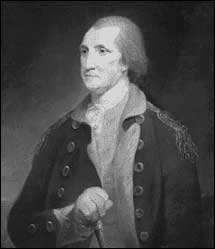| ||
A More Perfect Union:
The Creation of the U.S. Constitution Robert Morris of Pennsylvania, the "financier" of the Revolution, opened the proceedings with a nomination--Gen. George Washington for the presidency of the Constitutional Convention. The vote was unanimous. With characteristic ceremonial modesty, the general expressed his embarrassment at his lack of qualifications to preside over such an august body and apologized for any errors into which he might fall in the course of its deliberations. To many of those assembled, especially to the small, boyish-looking, 36-year-old delegate from Virginia, James Madison, the general's mere presence boded well for the convention, for the illustrious Washington gave to the gathering an air of importance and legitimacy But his decision to attend the convention had been an agonizing one. The Father of the Country had almost remained at home. Suffering from rheumatism, despondent over the loss of a brother, absorbed in the management of Mount Vernon, and doubting that the convention would accomplish very much or that many men of stature would attend, Washington delayed accepting the invitation to attend for several months. Torn between the hazards of lending his reputation to a gathering perhaps doomed to failure and the chance that the public would view his reluctance to attend with a critical eye, the general finally agreed to make the trip. James Madison was pleased.
The Articles of Confederation The determined Madison had for several years insatiably studied history and political theory searching for a solution to the political and economic dilemmas he saw plaguing America. The Virginian's labors convinced him of the futility and weakness of confederacies of independent states. America's own government under the Articles of Confederation, Madison was convinced, had to be replaced. In force since 1781, established as a "league of friendship" and a constitution for the 13 sovereign and independent states after the Revolution, the articles seemed to Madison woefully inadequate. With the states retaining considerable power, the central government, he believed, had insufficient power to regulate commerce. It could not tax and was generally impotent in setting commercial policy It could not effectively support a war effort. It had little power to settle quarrels between states. Saddled with this weak government, the states were on the brink of economic disaster. The evidence was overwhelming. Congress was attempting to function with a depleted treasury; paper money was flooding the country, creating extraordinary inflation--a pound of tea in some areas could be purchased for a tidy $100; and the depressed condition of business was taking its toll on many small farmers. Some of them were being thrown in jail for debt, and numerous farms were being confiscated and sold for taxes. In 1786 some of the farmers had fought back. Led by Daniel Shays, a former captain in the Continental army, a group of armed men, sporting evergreen twigs in their hats, prevented the circuit court from sitting at Northampton, MA, and threatened to seize muskets stored in the arsenal at Springfield. Although the insurrection was put down by state troops, the incident confirmed the fears of many wealthy men that anarchy was just around the corner. Embellished day after day in the press, the uprising made upper-class Americans shudder as they imagined hordes of vicious outlaws descending upon innocent citizens. From his idyllic Mount Vernon setting, Washington wrote to Madison: "Wisdom and good examples are necessary at this time to rescue the political machine from the impending storm." Madison thought he had the answer. He wanted a strong central government to provide order and stability. "Let it be tried then," he wrote, "whether any middle ground can be taken which will at once support a due supremacy of the national authority," while maintaining state power only when "subordinately useful." The resolute Virginian looked to the Constitutional Convention to forge a new government in this mold. The convention had its specific origins in a proposal offered by Madison and John Tyler in the Virginia assembly that the Continental Congress be given power to regulate commerce throughout the Confederation. Through their efforts in the assembly a plan was devised inviting the several states to attend a convention at Annapolis, MD, in September 1786 to discuss commercial problems. Madison and a young lawyer from New York named Alexander Hamilton issued a report on the meeting in Annapolis, calling upon Congress to summon delegates of all of the states to meet for the purpose of revising the Articles of Confederation. Although the report was widely viewed as a usurpation of congressional authority, the Congress did issue a formal call to the states for a convention. To Madison it represented the supreme chance to reverse the country's trend. And as the delegations gathered in Philadelphia, its importance was not lost to others. The squire of Gunston Hall, George Mason, wrote to his son, "The Eyes of the United States are turned upon this Assembly and their Expectations raised to a very anxious Degree. May God Grant that we may be able to gratify them, by establishing a wise and just Government." |

No comments:
Post a Comment